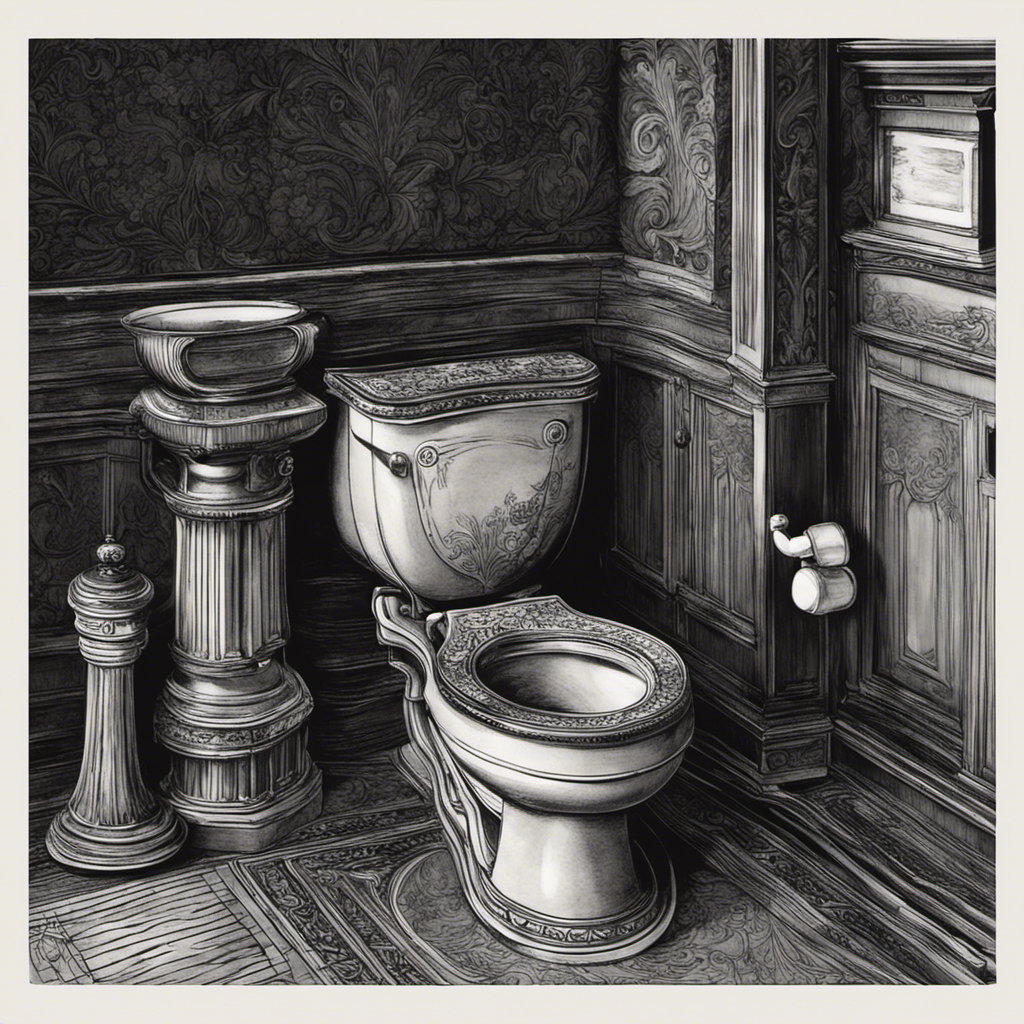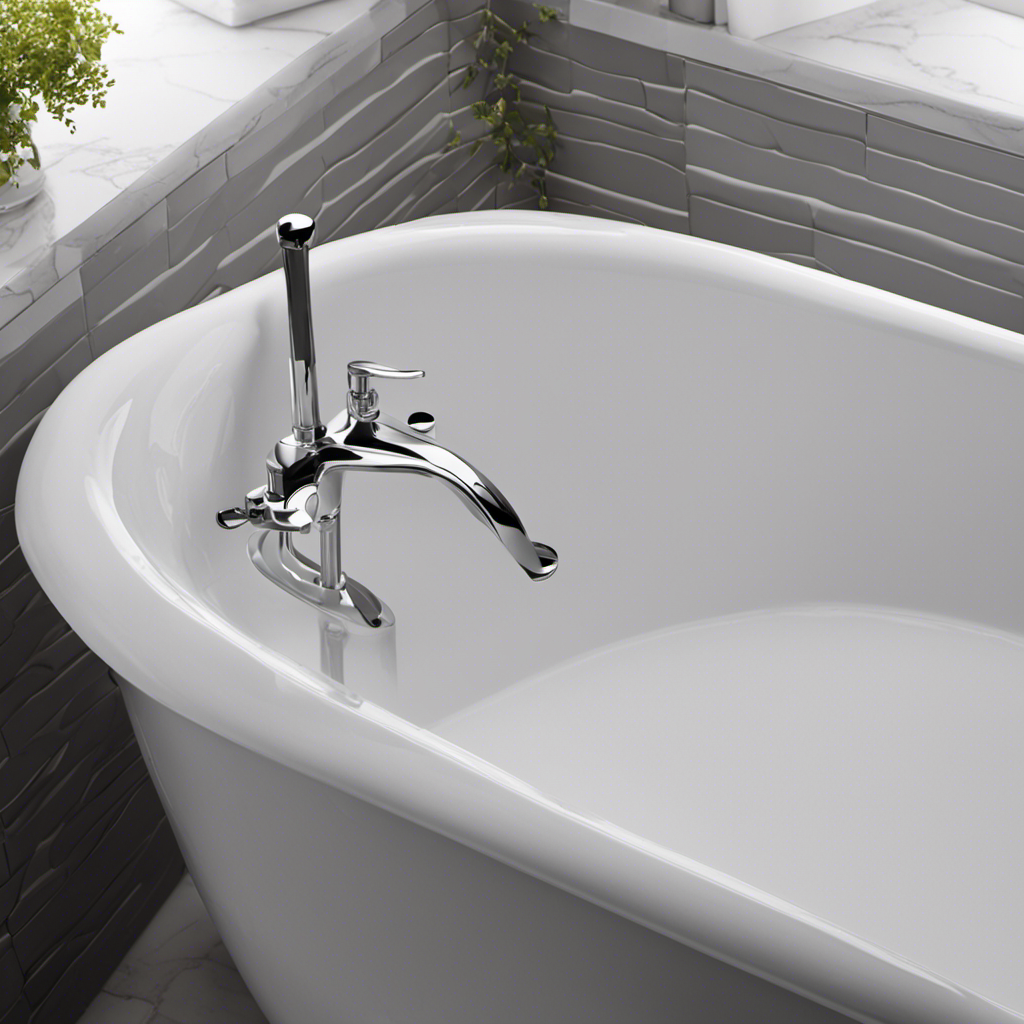Do you find yourself staring at the cracks in your bathtub, wondering how they got there? Well, fear not, because in this article, we will delve into the common causes of bathtub cracking and equip you with the knowledge to repair and prevent them.
From temperature changes to poor installation, we’ll uncover the secrets behind these pesky cracks.
So grab your tools and get ready to bid farewell to those unsightly cracks once and for all.
Key Takeaways
- Excessive weight or pressure, materials used in construction, improper installation, and lack of professional bathtub inspection are common causes of bathtub cracking.
- Visible cracks on the surface, spongy or soft spots on the tub floor, water stains or discoloration around the cracks, and potential dangers such as water leakage and structural damage are signs and symptoms of a cracked bathtub.
- Factors contributing to bathtub cracks include temperature changes, poor installation, and age and wear of materials.
- Poor installation leads to stress points and eventual cracks, proper maintenance and regular inspection are crucial, and maintaining consistent water pressure helps prevent cracks.
Common Causes of Bathtub Cracking
One of the most common causes of bathtub cracking is excessive weight or pressure on the surface. Bathtubs are designed to withstand a certain amount of weight, but if it is exceeded, cracks can occur.
Additionally, the materials used to construct bathtubs can also contribute to cracking. For instance, acrylic and fiberglass bathtubs are more prone to cracking compared to cast iron or porcelain ones.
It is important to note that improper installation or inadequate support for the bathtub can also lead to cracking. To ensure the longevity of your bathtub, it is recommended to have a professional bathtub inspection done regularly. This will help identify any potential issues and ensure that necessary repairs or reinforcements are made promptly.
Understanding the causes of bathtub cracking is crucial in recognizing the signs and symptoms of a cracked bathtub.
Signs and Symptoms of a Cracked Bathtub
There are several signs and symptoms to look out for when identifying a cracked bathtub. Not only can a cracked bathtub be unsightly, but it can also pose potential dangers if not addressed promptly. Here are some key indicators that your bathtub may be cracked:
| Signs and Symptoms | Description | Potential Dangers |
|---|---|---|
| Visible cracks | Cracks that can be seen on the surface of the tub | Water leakage, structural damage |
| Spongy or soft spots | Areas on the tub floor that feel weak or unstable | Increased risk of accidents |
| Water stains or discoloration | Discoloration or stains around the cracks | Mold and mildew growth |
If you notice any of these signs, it is crucial to take action and repair the cracks as soon as possible. Ignoring them can lead to more extensive damage and even costly repairs down the line. Don’t underestimate the potential dangers of a cracked bathtub. Seek professional assistance to ensure the safety and longevity of your bathroom.
Understanding the Impact of Temperature Changes on Bathtub Cracks
To understand how temperature changes affect your bathtub cracks, it’s important to consider the expansion and contraction of materials. When exposed to heat, the materials in your bathtub expand, and when exposed to cold, they contract. Over time, these repeated cycles of expansion and contraction can have long-term effects on the structure of your bathtub.
The long-term effects of temperature changes on your bathtub structure include:
- Cracks: The constant expansion and contraction can cause stress on the bathtub materials, leading to cracks.
- Leaks: Cracks in the bathtub can result in leaks, causing water damage and further deterioration.
- Weakening of the structure: The repeated stress from temperature changes can weaken the overall structure of the bathtub, making it more prone to further damage.
It’s important to note that temperature changes are not the only factors contributing to bathtub cracking. Other factors include:
- Poor installation: Incorrect installation or inadequate support can lead to stress points and eventual cracking.
- Impact damage: Dropping heavy objects or applying excessive force can cause cracks in the bathtub.
- Age and wear: Over time, the materials in the bathtub can deteriorate, making them more susceptible to cracking.
The Role of Poor Installation in Bathtub Cracks
If you have poor installation of your bathtub, it can lead to stress points and eventual cracks. Proper installation is crucial to prevent these issues and ensure the longevity of your bathtub.
One of the key factors in preventing cracks is proper maintenance. Regularly inspecting your bathtub for any signs of wear or damage and promptly addressing them can help prevent cracks from forming.
Additionally, it is important to understand the role of water pressure in bathtub crack formation. High water pressure can create stress on the walls of the bathtub, increasing the likelihood of cracks. It is essential to maintain a consistent water pressure to prevent this from happening.
By understanding the importance of proper maintenance and water pressure, you can take proactive measures to avoid bathtub cracks.
Now, let’s explore how to repair and prevent bathtub cracking.
How to Repair and Prevent Bathtub Cracking
Regularly inspecting for signs of wear and promptly addressing them can help prevent and repair cracks in your bathtub. By following these simple steps, you can maintain your bathtub and avoid costly repairs:
-
Clean and dry the bathtub thoroughly before starting any repairs.
-
Remove any loose debris or dirt from the crack using a soft brush or cloth.
-
Apply a bathtub repair kit or epoxy resin to the crack, following the manufacturer’s instructions.
-
Avoid using abrasive cleaners or tools that can further damage the bathtub’s surface.
-
Use a non-slip mat or adhesive strips to prevent slips and falls in the bathtub.
-
Avoid filling the bathtub with excessive amounts of water, as it can put additional strain on the bathtub’s structure.
-
Regularly inspect the bathtub for any signs of wear or damage, such as discoloration, chips, or cracks. Promptly address any issues to prevent further damage.
Following these simple maintenance tips and DIY repair techniques can help prolong the lifespan of your bathtub and keep it in excellent condition for years to come.
Frequently Asked Questions
Can a Cracked Bathtub Cause Water Damage to My Home?
A cracked bathtub can indeed cause water damage to your home. It can lead to leaks and seepage, which can damage the floors, walls, and ceilings. Regular maintenance and proper usage can help prevent such issues.
How Long Does It Typically Take for a Bathtub to Crack?
Bathtub cracks can occur due to various factors such as age, poor maintenance, and excessive weight. It’s important to regularly inspect your bathtub, address any issues promptly, and follow proper maintenance practices to prevent cracks.
Are There Any Health Risks Associated With Using a Cracked Bathtub?
Using a cracked bathtub can pose long term health risks. Water leakage can lead to mold and mildew growth, which can trigger respiratory problems. Regular maintenance and repairs, such as sealing cracks, can ensure safety and hygiene.
Can You Still Use a Cracked Bathtub or Does It Need to Be Replaced Immediately?
Can you still use a cracked bathtub? It depends on the severity. Minor cracks can be repaired, but for major ones, it’s best to replace it immediately to avoid further damage and potential health risks. Explore bathtub repair options and maintenance tips for a longer-lasting solution.
Are There Any Warning Signs to Look Out for That Indicate a Bathtub Is at Risk of Cracking?
To prevent bathtub cracks and maintain your bathtub, look out for warning signs like visible cracks, leaks, or unusual noises. Regularly clean and dry the tub, avoid using harsh cleaning agents, and be cautious when placing heavy objects on the surface.
Conclusion
Now that you understand the common causes, signs, and symptoms of a cracked bathtub, as well as the impact of temperature changes and poor installation, you have the knowledge to investigate the truth of a theory.
By taking the necessary steps to repair and prevent bathtub cracking, you can ensure the longevity and enjoyment of your bathtub.
Remember, regular maintenance and proper installation are key in avoiding costly repairs and maintaining a functional and beautiful bathtub.
Keep your tub in top shape and continue to enjoy relaxing baths for years to come.










